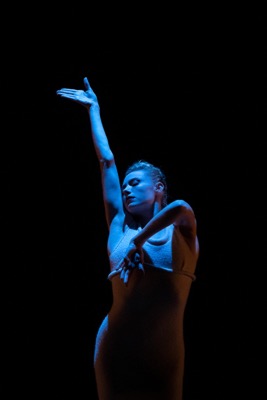
It wouldn’t be entirely fair to call Sara Mearns a force of nature, given her discipline, her skills as a principal dancer with the New York City Ballet, and her interest in exploring new possibilities. However having seen her perform August 14-18 in Jacob’s Pillow’s Doris Duke Theater, I’m strenuously tempted.
The program titled “Sara Mearns: Beyond Ballet” features her in five works. Interestingly, only one of them was choreographed entirely by a man: an excerpt from Daphnis and Chloe, a work-in-progress by Christopher Williams. Even more interesting: all of the program’s three duets pair Mearns with women: her NYCB colleague and friend Ashley Bouder; postmodern dancer-choreographer Jodi Melnick (another good friend); and Honji Wang, co-director and co-choreographer with Sébastien Ramirez of Company Wang Ramirez.
It’s especially fascinating to watch Mearns perform at fairly close range in a black-box theater such as the Duke. She doesn’t play to the audience and seems always to have some sort of story running in her head. This quality is not distracting or mystifying. It only means that her focus and the dynamics of her movements change subtly as she dances, and draw you in.
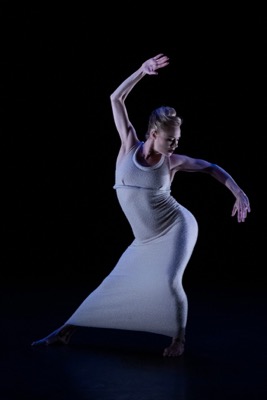
As I said when I wrote in 2017 about Virginie Mécène’s reimagination of Martha Graham’s 1933 Ekstasis, there’s no way of knowing how much it resembles the original work, scrupulously researched by Mécène (once a dancer in Graham’s company, now program director of its school). The solo is now performed to the haunting “Interludi meditatiu VII” from Ramon Humet’s Homenaje a Martha Graham (for piano, soprano, shakuhachi, and four percussion instruments). The words in another section from that suite capture something of Mécène’s intent:
“Everything changes, the only truth./ Time invokes change,/not to change deliberately./ Only what changes remains.”
Mearns appears in a pool of light, wearing a long tube of a garment similar to what Graham wore, her hair upswept and braided. As she begins to move, she briefly strokes her hand down one hip, and, indeed, the choreography seems to bend her body into angles, her hips thrusting one way, her shoulders leaning another. Yet her every move is thoughtful, exploratory, as if ecstasy lay just beyond her reach. After spinning through the space, she returns to her place, reinforcing the image of a figure lost in time.
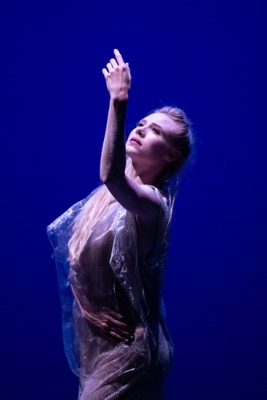
The other solo she performs is the one by Christopher Williams, and it’s set to an excerpt from Maurice Ravel’s 1912 Daphnis and Chloé (originally written for Mikhail Fokine’s ballet for Serge Diaghilev’s Ballets Russes). It’s the music that accompanies Chloé when she is ordered to dance by the chief of the pirates who have captured her. Costumed in flowing draperies by Reid Barthelme and Harriet Jung that swirl around Mearns when she spins across the stage, she sometimes reaches out with cupped hands, as if imploring her captors to release her. But she also glances about as she dances (perhaps hoping to escape?). It’s amazing how much Mearns manages to convey without breaking the flow of the choreography. Mike Faba’s lighting (based on Serena Wong’s design) changes the backdrop from orange to red to pink, diminishes it to a blue spotlight, and turns her into an imploring silhouette. I’m looking forward to Williams’s finished work.
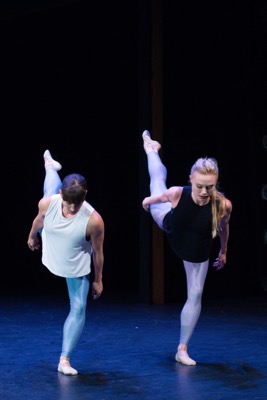
Liz Gerring’s elegantly structured Duet offers an underlying theme: two women work side by side, rarely if ever touching, and pursuing separate choreographic strands that occasionally merge into unison or echo each other. The accompanying score by composer and sound artist Michael J. Schumacher gives Mearns and Bouder more of an aural terrain than a rhythmic ground, and Carbone 38 dresses them in attractive practice attire.
The two are first seen facing away from us on a diagonal, each extending one leg in a high arabesque. The music begins, but they move in unison for only a few seconds. Coolly and beautifully they investigate their own patterns. Bouder may, for example, jump up a few times, legs bent, while Mearns prefers to bend extremely far back. Yet soon they’re side by side again, each raising her leg to the front and slowly revolving into other precarious balances. Only once do they make physical contact: Mearns steadies herself by placing one hand on Bouder’s bent-over back. Separate yet aware of each other, they remain calm amid the music’s jitters and disruptions. They’re sitting on the floor and looking at one another as the lights dim.
As a dancer, Jodi Melnick once worked with artists as diverse as Twyla Tharp and Mikhail Baryshnikov, and she has choreographed for and with many other groups. It may have been in 2015, during a series of surprising choreographer-dancer linkages at Danspace Project in New York’s St. Mark’s Church that she met Mearns. (Mearns had been paired with postmodernist Rashaun Mitchell and Melnick with New York City Ballet’s Sterling Hyltin; all four collaborated).
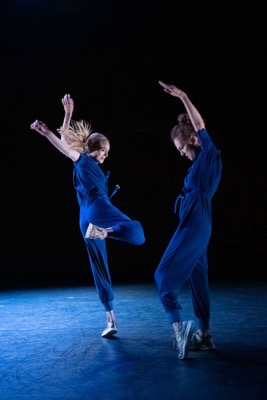
For Melnick’s Opulence into part 2, Mearns and the choreographer appear in handsome royal blue outfits by Kaye Voyce with J.E.M. plus sneakers. Tei Blow’s sound design (drums by Kid Millions, guitar by Zach Lehrhoff) mixes music with words that tell us that a rehearsal is going on. The first thing we hear, however, is the furious rattle of paper—or maybe it’s plastic (we can’t know since we’re sitting in the dark). As Faba brings the lights up, we can see that Melnick is attempting to spread and then pile in one corner a large, billowing sheet of blue plastic.
In Opulence into part 2, as in Gerring’s Duet, the two women often pursue separate paths and sometimes seem to be measuring the distances of their habitat with their gestures. They also, once, press together, one’s front against the other’s back. They often pause. Mearns sits and watches Melnick dance. Once, Melnick grabs Mearns’s arm and lifts it (after all, she’s the choreographer). They dance strenuously together, so subtly different that their unison isn’t exact. If you watch Melnick carefully, you may see small impulses travel through her body; Mearns is slightly less indirect. They’re fascinating together, and, as the piece develops, they seem to be enjoying themselves more and more.
There’s a little joke too. Or maybe it’s a prediction. The title Opulence into part 2 all but gives it away. As Mearns and Melnick are leaving the stage, six staff members and interns of the Pillow walk on and start dancing in unison a strenuous, pretty complex phrase. These are their names: Akinyemi Blackshear, Sienna Jesurun, Lydia Murray, Annie Peterson, Madalyn Rupprecht, Izzi Wayner. They’re onstage for only a few seconds, so you hardly get to know them. But, hey, maybe we’ll see part 2 another summer. Or not?
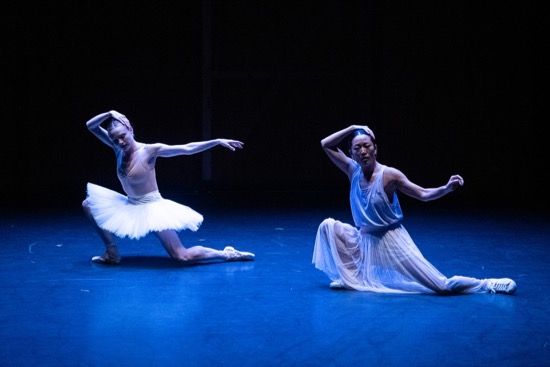
We’re introduced to Company Wang Ramirez’s No. 1 in a striking film by Laurent Daufès and Sébastien Ramirez of Mearns and Honji Wang dancing on the Pillow’s Inside/Out stage. Then the live piece, which was commissioned by Jacob’s Pillow and premiered there in 2017, starts rather mysteriously. The house lights are still on, but Wang is visible onstage. Is she trying to creep away?? She jitters, pauses, and the whole theater becomes black. We hear some noise backstage. Accidental? Who knows.
When the lights come back on after a slight pause, Wang is alone onstage, wearing a loose blouse, a long, pale skirt and sneakers that occasionally squeak against the floor. We hear a bit of music and a voice saying, “I wanted to be a ballet dancer.” She’s edgy, looking around, when a ballet barre slides magically across the stage under its own steam (apparently). She loves this barre very very much and is caressing it when Mearns walks in, puts a hand on it, and starts doing the little tendus with which a ballet class may begin. She’s wearing pointe shoes and sports a tutu. Wang balances on the barre on her belly to get a better view and makes it clear that she is not a ballet dancer by lifting one leg and then the other with her feet flexed, not pointed.
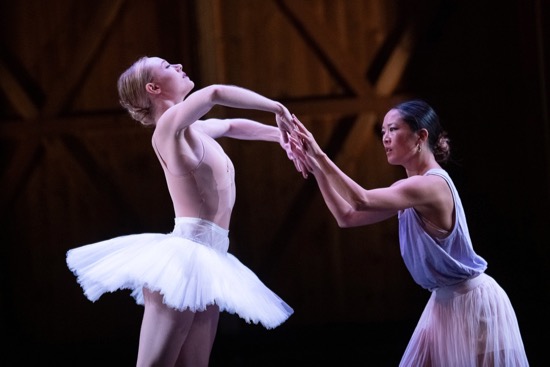
The barre slides offstage, and the women get down to business. Sometimes Wang duplicates what Mearns is doing. Sometimes she does her own version of it. She also provides support and manages not to get too much in Mearns’s way during her tricky investigations. In a show of her strength and helpfulness, she gets Mearns draped over her back and lugs her along. Mearns is unperturbed. If Wang is rolling over the floor, she steps serenely back and forth across her. There’s a certain sweetness to the women’s relationship, even though we’re led to believe that nothing is easy for Wang and that nothing Mearns does goes unexamined by her.
The program showcases much more than Mearns’s phenomenal skill as a dancer. It reveals her as an inquisitive and generous collaborator—a performer who wants to adventure along paths new to her when she takes time off from her demanding day job as an NYCB star. You go girl!

Thanks Deborah, for these wonderful descriptions of Mearns’s performances of new and different dances. I wish I could have seen them — I’ve been a fan from way back — spotted her as special even before she became a star. Her performance of Isadora’s dances at last year’s Fall for Dance was an indication that there are no limits to her talents.
Hi….Sara is a beautiful dancer but my husband and I must admit we so much more enjoy her when she is performing in the Classical Vein where she always shines. We truly understand that she is wanting to reach out in a different style but simply want her as we long since think of her. Sara is sooo incredibly capable that what she did in our humble opinion simply didn’t show her off for what she can do !